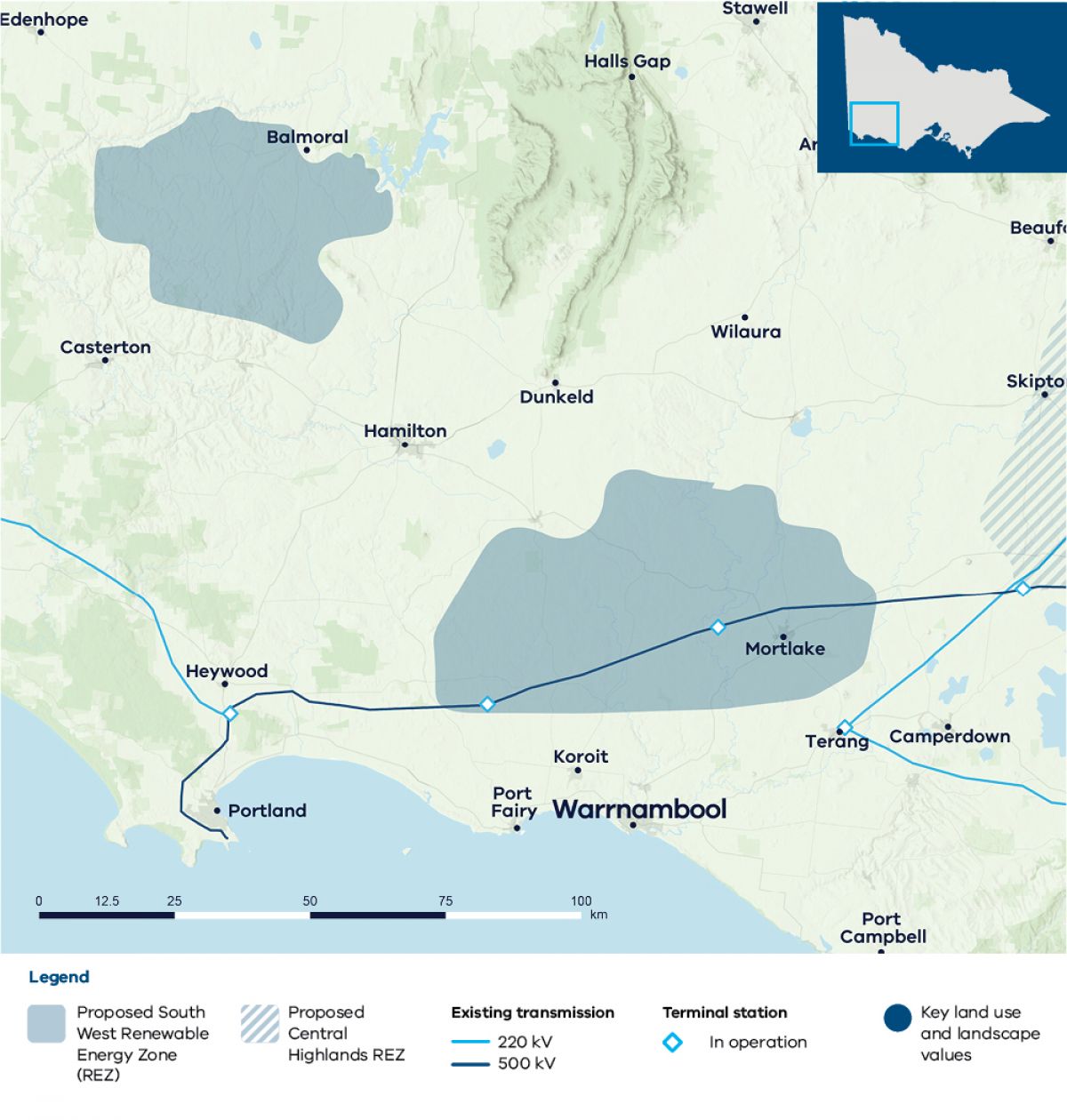On this page:
A renewable energy zone with 2 sections is proposed in South West Victoria as part of the 2025 Victorian Transmission Plan.
The zone includes new areas that were not previously identified in the draft Victorian Transmission Plan.
Before being officially declared by the Minister for Energy and Resources, there will be a further chance to provide your feedback. For more information, visit Engage Victoria.
Where is the zone?
The proposed South West Renewable Energy Zone includes parts of the Moyne and Southern Grampians local government areas. Small parts of the zone also sit within Glenelg, Corangamite and West Wimmera local government areas.
The proposed zone has 2 sections – one south-east of Hamilton between Macarthur and Darlington, and one north-west of Hamilton between Casterton and Balmoral.
The south-east section is within the Registered Aboriginal Party boundaries of Eastern Maar Aboriginal Corporation and Gunditj Mirring Traditional Owners Aboriginal Corporation. The north-west section is within the boundaries of Gunditj Mirring Traditional Owners Aboriginal Corporation.
This zone has been split into 2 sections in response to feedback about potential impacts on farmland and environmental and cultural values south-west of Hamilton, and calls for land near Coleraine to be considered for inclusion.

How feedback shaped the zone
Community and industry views have been crucial to the design of the 2025 Victorian Transmission Plan.
VicGrid's role is to balance the need for new renewable projects that will deliver reliable and affordable power with a range of other factors, including how we minimise impacts on landholders, communities, agriculture, the environment and power bills.
Not all community or industry requests have been adopted.
The Victorian Transmission Plan reflects difficult choices, made by weighing up many factors to deliver a plan that best serves all Victorians.
What we heard through feedback
- Consideration needs to be given to the significant role this region has already played in Victoria's energy transition so far, noting the large number of uncoordinated existing and proposed local renewable projects.
- Minimise cumulative impacts of wind projects, particularly on visual amenity and how overdevelopment affects peoples' sense of place and way of life.
- Minimise impacts on agriculture, particularly dairy farmland, in recognition of the sector’s contribution to the local economy and food security.
- Protect biodiversity, including the brolga and southern bent-wing bat.
- Avoid the north-west portion of the draft proposed renewable energy zone due to ground water access and associated agricultural productivity, areas of environmental and cultural significance, less access to reliable wind and lack of developer interest.
- Consider including land near Coleraine in the zone.
What we did
- Worked to avoid agricultural land, including concentrated dairy farming areas.
- We protected significant landscapes and landforms, including Budj Bim World Heritage Site, the Grampians (Gariwerd) National Park, Lake Corangamite, Great Otway National Park and coastal areas.
- We protected the habitat of species such as the brolga, especially areas with a high concentration of wetlands to the east and north-east of the draft proposed renewable energy zone.
- We adjusted the shape of the draft proposed zone, removing the area south-west of Hamilton and an area of brolga flocking grounds south of Dunkeld that would have restricted planning of new wind turbines.
- We added a new stand-alone section of the zone near Coleraine that offers access to stronger wind than the area removed.
To find out more, read the Proposed South West Renewable Energy Zone factsheet.
Next steps
Communities within proposed renewable energy zones can continue to provide feedback and seek more information about renewable energy zones, including through face-to-face meetings with VicGrid.
We will invite formal feedback about the proposed South West Renewable Energy Zone as part of the official declaration process.
There will be 6 weeks of consultation which will give landholders, communities and Traditional Owners another opportunity to provide feedback and shape decision-making. The timing for this will be announced in the coming weeks.
To stay up to date, subscribe to our newsletter.
Call us on 1800 418 341 or email vicgrid@deeca.vic.gov.au
Page last updated: 17/08/25
